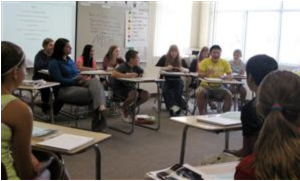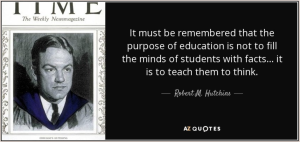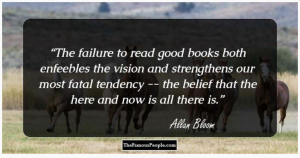5 Chapter 5: Perennialism
Dr. Della Perez
Perennialism

This chapter will explore the first of six philosophies of education. A philosophy provides educators with a “framework for determining broad issues and tasks, the process of teaching and learning, and in general, what experiences and activities to stress in schools and classrooms” (Ornstein, 1991, p. 102). The six key philosophies of education that will be explored in this text are: Perennialism, Progressivism, Behaviorism, Essentialism, Social Reconstructionism, and Postmodernism. The in-depth look at Perennialism, which will be provided in this chapter, will begin with an overview of the key characteristics of Perennialism. Information related to the curriculum, instructional methods, the role of the teacher, and role of the learner will also be explored. Finally, key proponents of Perennialism and their contributions will be discussed.
Section I: Characteristics of Perennialism
5.1 Essential Questions
By the end of this section, the following essential questions will be answered:
- In what schools of thought is Perennialism rooted?
- What is the educational focus of Perennialism?
- What do Perrenialists believe are the primary goals of schooling?
Perennialism is identified as a very conservative theory of education. Rooted in the following schools of thought: idealism, realism, and neo-Thomism, the educational focus of perennialism is on finding universal truths and absolutes associated with reason and faith (Webb et. al., 2010). According to this theory of education, truth is universal and does not change.
The literal definition of perennial means “everlasting” or something that “returns year after year.” As implied by its name, perennialism is based upon the belief that there are everlasting ideas and universal truths. Therefore, the primary goal of education within this philosophy is to search for and disseminate truth. In addition, this philosophy of education advocates for the cultivation of human intellect.
5.2 A Closer Look
The following article provides a detailed overview of Perennialism. This chapter will provide a review of the following key concepts:
- Historical Retrospect of Perennialism
- Forms of Perennialsim
- Philosophical Rationale
After reading the article, please respond to the following questions to consider.
- Who were some of the key contributors to this philosophy?
- What are the two main forms of this philosophy?
- Who is the philosophical rationale behind this philosophy?
Perennialism in Education [https]
Section II: Curriculum
5.3 Essential Questions
By the end of this section, the following essential questions will be answered:
- How does the curriculum differ among Ecclesiastical Perennialist and Lay (secular) Perennialists?
- What are the goals within a Perennialist curriculum?
- Do you think the focus of this curriculum is beneficial for students? Why or why not?
There are two main types of Perennialist. Ecclesiastical Perennialists and Lay (secular) Perennialists. Both groups have had a significant influence on the type of curriculum used in Perennialist classrooms.
Ecclesiastical Perennialists
Ecclesiastical Perennialists followed a Christian doctrine. Consequently, curriculum taught by this group focused on developing intellect while stressing faith and reason by creating a relationship with God (Webb et. al., 2010). The stress on faith was seen in the use of scriptures, the catechism, and instruction on Christian dogma. St. Thomas Aquinas (1224- 1274), who is the patron saint of Catholic schools, colleges and universities, is a noted ecclesiastical philosopher.
Lay (Secular) Perennialists
Historically, Lay Perennialists emphasized a strong liberal arts curriculum that included: “philosophy; mathematics; history; geography; political science; sociology; theology; languages and literature; physical and life sciences; and the fine arts and humanities” (Webb et. al., 2010, p. 71). In order for students to become truly intellectual beings, they needed to be able to master each of these subject areas according to the Perennialist philosophy. One way to do this was by reading the Great Books of the Western World Program. The program identified 100 of the “classic” literature books that Perennialist argue must be taught to students to cultivate students intellect and civilization. Other aspects of the curriculum taught by Lay Perennialists were character training and moral development.
In the last 100 years, Perennialists are more focused on using the curriculum as a context for developing intellectual skills like those associated with the three R’s (reading, writ- ing, and arithmetic). One of the reasons for a more uniform approach to curriculum is the idea of a one-size-fits-all mentality. According to the Perennialist philosophy, carefully supervised exposure to permanent studies helps to create rational, enlightened, and intellectually stimulated citizens.
5.4 An Example in Practice

St. John’s College in Annapolis, Maryland is a great example of a University that follows a Perennialist philosophy. At St. John’s, classes emphasize the discussion of foundational works of philosophy, literature, history, theology, politics, economics, psychology, music, mathematics, and laboratory sciences. The faculty promote an educational focus that privileges intellectual engagement and they regard themselves as guides and mentors whose task is to pose questions that further the student’s ability to think critically. Students, on the other hand, are encouraged to formulate questions and develop their thoughts in dialogue with one another using strategies like Socratic circles.
Instruction in the Classroom
5.5 Essential Questions
By the end of this section, the following essential questions will be answered:
- What are the main methods of instruction in a Perennialist classroom?
- What is the teachers role in the classroom?
- What is the students role in the classroom?
- What strategies do students use in Perennialist classrooms?
At the elementary level, a Perennialist teacher would be focusing on the management and teaching of basic educational skills. To support educators in meeting this goal, they are supposed to use the “Great Books” of Western civilization.

Adler (1984) also suggested the following three methods of instruction:
- Didactic Instruction
- Coaching
- Socratic Method
In order to prepare students for the instruction they would receive in a Perennialist classroom, they first needed to be taught how to think critically. In addition, they would have to learn questioning strategies so they could engage in meaningful “dialogue” about the classical writers they would be reading (Webb et. al., 2010).
Teachers Role
For Perennialists, the teacher is seen as the authority figure in the classroom. As the authority figure, it is up to the teacher to disseminate the truth. The teacher can do this by acting as a seminar leader or coach. According to Adler (1984), as a seminar leader, the teacher illustrates the power of the literature being read through questioning. When done correctly, this questioning should help students think rationally. One of the most popular methods for questioning students is the Socratic Method.
5.6 An Example in Practice
For an example of the Socratic Method, please watch the video titled: Socratic Seminar Strategies for the Second Grade Classroom. As you are watching the video, think about how this teacher is acting as a seminar leader or coach for her students.
For an example of the Socratic Method being used at the Secondary Level, please watch the video titled: Socratic Seminar in Action in the Secondary ELA Classroom. Once again, as you are watching the video, think about the key elements of the Socratic Method that stand out to you.
As demonstrated in the video, the coach or teacher needs to closely watch the students, offer immediate feedback or “shrewd” criticism, and engage them in repetitive skill-drill exercises. In addition, a successful coach and teacher within this philosophy needs to:
- Be well versed in the classics
- Possess a good memory
- Be capable of the highest forms of reasoning (Webb, 2010).

1. Do you think you have the skills to be a seminar leader? Why or why not?
2. What qualities do you have that would make you a good coach? What would you need to improve upon?
Students Role
The students are supposed to learn the “truth” as taught to them by the teacher. Since truth does not change, students’ interests or experiences are not reflected in what is taught in a Perennialist classroom. In fact, the issue of diversity is not even relevant, because learning is not about diversity.
5.7 An Example in Practice
For a more information about the Perennialist philosophy, please watch the following video. As you watch the video, please document your response to the following questions to consider.
1. What additional insights did you gain about the Perennialist philosophy?
2. Can you relate elements of this philosophy to your own educational experiences? If so, how? If not, can you think of an example?
Key Educators
5.8 Essential Questions
By the end of this section, the following Essential Questions will be answered:
- Who were the key proponents of Perennialism?
- What impact did each of the key educators of Perennialism have on this philosophy of education?
Historically, this philosophy reflects the views of Plato and Aristotle. The search for truth, which is the basis of this philosophy, can be seen in both of these famous philosophers works. Other historical philosophers who greatly influenced the development of Perennialism were St. Thomas Aquinas (1224 – 1274) and Jacques Maritain (1882-1973). Both of these philosophers represented the Ecclesiastic Perennialist position. As such, they argued that intelligence alone was not sufficient to understand the universe, it was also critical to have a relationship with a higher Spiritual being.
Lay (secular) philosophers that have influenced perennialism include: Robert M. Hutchins, Mortimer Adler, and Allan Bloom.
Robert M. Hutchins (1899 – 1977)
Robert M. Hutchins was a chancellor of the University of Chicago who argued that the ideal education is one that is designed to develop the mind (Webb, 2010). To support the development of the mind, he proposed a curriculum based on the “Great Books” of Western civilization.
Hutchins believed in what he called the “permanent studies.” These were core courses in liberal arts whose content did not change. As such, he argued that selecting 100 “Great Books” and teaching them to students naturally aligned with these permanent studies. Sample titles of the first 10 out of 54 Volumes of the “Great Books” include:

- Volume 1: The Great Conversation
- Volume 2: Syntopicon I
- Volume 3: Syntopicon II
- Volume 4: Homer
- Volume 5: Aeschylus, Sophocles, Euripides, Aristophanes
- Volume 6: Herodotus & Thucydides
- Volume 7: Plato
- Volume 8: Aristotle
- Volume 9: Aristotle
- Volume 10: Hippocrates & Galen
Mortimer Adler

Mortimer Adler proposed a curriculum that would be appropriate for all students. Within such a curriculum, students would be taught language, literature, mathematics, natural sciences, fine arts, history, geography, and social studies (Webb et. al., 2010).
He also advocated for the use of the “Great Books” by arguing that students could learn a lot from the great works of the past. Both Adler and Hutchins opposed any form of differentiated curricula (e.g., vocational, technical, or academic) under the guise that all students in a democratic society should have access to the same high-quality education.
Allan Bloom
Allan Bloom wrote The Closing of the American Mind (2012). In this book, he talks about “cultural  illiteracy” being a crisis in today’s society. In order to address this crisis, he advocates teaching and learning about the “Great Books” because they provide knowledge and in- formation that has lasting significance (Webb et. al., 2010). He sees this crisis as being particularly significant at the university level.
illiteracy” being a crisis in today’s society. In order to address this crisis, he advocates teaching and learning about the “Great Books” because they provide knowledge and in- formation that has lasting significance (Webb et. al., 2010). He sees this crisis as being particularly significant at the university level.

Reflect on your learnings about Perennialism. Write down three things you learned about this philosophy of education, two things you found surprising, and one professional connection you can make to your future professional practice.
References
Adler, M. J., (1984). The Paidiea program: An educational syllabus. Touchstone.
Bloom, A. (Reissue). (2012). The closing of the American mind: How higher education has failed democracy and impoverished the souls of today’s students. Simon & Schuster.
Webb, L. D., Metha, A., & Jordan, K. F. (2010). Foundations of American Education. Pearson Merrill.
